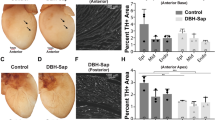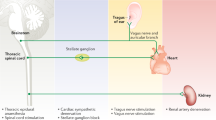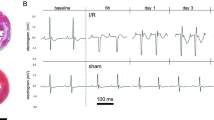Key Points
-
After initial reports of the successful treatment of patients with angina, left cardiac sympathetic denervation (LCSD) entered clinical practice in the 1970s for patients with long QT syndrome (LQTS)
-
LCSD prevents arrhythmias of ischaemic origin, raises the threshold for ventricular fibrillation (VF), does not induce postdenervation supersensitivity, improves the capacity of coronary arteries to dilate, and preserves cardiac contractility
-
The different effects of LCSD versus right cardiac sympathetic denervation are explained by the fact that the left-sided cardiac sympathetic nerves are quantitatively dominant at the ventricular level
-
LCSD has proved to be highly effective in preventing life-threatening cardiac arrhythmias in patients with LQTS, catecholaminergic polymorphic ventricular tachycardia, or those at high cardiovascular risk after myocardial infarction
-
Preliminary data, and important effects on VF threshold, suggest that LCSD might be useful in many conditions characterized by high risk of life-threatening arrhythmias, including ischaemic, dilated, and hypertrophic cardiomyopathy
-
Cardiologists should discuss the advantages and disadvantages of LCSD compared with those of an implantable cardioverter–defibrillator with all patients, particularly children, who are at risk of arrhythmic sudden death
Abstract
Experimental and clinical evidence indicating an antiarrhythmic effect of cardiac sympathetic denervation has been available for 100 years. Experimental data show that left cardiac sympathetic denervation (LCSD), in particular, is not only antiarrhythmic, but also antifibrillatory—an effect exquisitely important for any clinical condition associated with a high risk of ventricular fibrillation and sudden cardiac death. LCSD has additional effects on both the coronary circulation and the mechanical performance of the left ventricle, with important implications for patients with ischaemic cardiomyopathy. Evidence also shows that LCSD increases the vagal activity directed to the heart, which has potential implications for the management of heart failure. In this Review, the current and novel clinical indications for LCSD are discussed, particularly in the context of results obtained in patients with channelopathies, such as long QT syndrome and catecholaminergic polymorphic ventricular tachycardia.
This is a preview of subscription content, access via your institution
Access options
Subscribe to this journal
Receive 12 print issues and online access
$209.00 per year
only $17.42 per issue
Buy this article
- Purchase on Springer Link
- Instant access to full article PDF
Prices may be subject to local taxes which are calculated during checkout





Similar content being viewed by others
References
Lown, B. Sudden cardiac death: the major challenge confronting contemporary cardiology. Am. J. Cardiol. 43, 313–320 (1979).
Task Force of the Working Group on Arrhythmias of the European Society of Cardiology. The Sicilian Gambit: a new approach to the classification of antiarrhythmic drugs based on their actions on arrhythmogenic mechanisms. Eur. Heart J. 12, 1112–1131 (1991).
Leriche, R., Herman, L. & Fontaine, R. Ligature de la coronaire gauche et fonction du cœur après énervation sympathique [French]. C. R. Soc. Biol. 107, 547–548 (1931).
Cox, W. V., Lewiston, M. E. & Robertson, H. F. The effect of stellate ganglionectomy on the cardiac function of intact dogs: and its effect on the extent of myocardial infarction and on cardiac function following coronary artery occlusion. Am. Heart J. 12, 285–300 (1936).
Schauer, G., Gross, L. & Blum, L. Hemodynamic studies in experimental coronary occlusion: IV. Stellate ganglionectomy experiments. Am. Heart J. 14, 669–676 (1937).
McEachern, C. G., Manning, G. W. & Hall, G. E. Sudden occlusion of coronary arteries following removal of cardiosensory pathways: an experimental study. Arch. Intern. Med. 65, 661–670 (1940).
Harris, A. S., Estandia, A. & Tillotson, R. F. Ventricular ectopic rhythms and ventricular fibrillation following cardiac sympathectomy and coronary occlusion. Am. J. Physiol. 165, 505–512 (1951).
Milch, E. et al. Experimental prevention of sudden death from acute coronary artery occlusion in the dog. Am. Heart J. 50, 483–491 (1955).
Skelton, R. B., Gergely, N., Manning, G. W. & Coles, J. C. Mortality studies in experimental coronary occlusion. J. Thorac. Cardiovasc. Surg. 44, 90–96 (1962).
Schaal, S. F., Wallace, A. G. & Sealy, W. C. Protective influence of cardiac denervation against arrhythmias of myocardial infarction. Cardiovasc. Res. 3, 241–244 (1969).
Ebert, P. A., Vanderbeek, R. B., Allgood, R. J. & Sabiston, D. C. Jr. Effect of chronic cardiac denervation on arrhythmias after coronary artery ligation. Cardiovasc. Res. 4, 141–147 (1970).
Fowlis, R. A. F., Sang, C. T. M., Lundy, P. M., Ahuja, S. P. & Colhoun, H. Experimental coronary artery ligation in conscious dogs six months after bilateral cardiac sympathectomy. Am. Heart J. 88, 748–757 (1974).
Schwartz, P. J. & Stone, H. L. Left stellectomy in the prevention of ventricular fibrillation caused by acute myocardial ischemia in conscious dogs with anterior myocardial infarction. Circulation 62, 1256–1265 (1980).
Schwartz, P. J. Cutting nerves and saving lives. Heart Rhythm 6, 760–763 (2009).
Francois-Frank, C. A. Signification physiologique de la resection du sympathique dans la maladie de Basedow, l'epilepsie, l'idiotic et le glaucoma [French]. Bull. Acad. Méd. Paris 41, 565–594 (1899).
Jonnesco, T. Traitement chirurgical de l'angine de poitrine par la résection du sympathique cervico-thoracique [French]. Presse Méd. 20, 221–230 (1921).
Danielopolu, D. Le traitement chirurgical de l'angine de poitrine à la lumière des dernières recherches cliniques et expérimentales [French]. C. R. Soc. Bio. Tome I 92, 1157 (1925).
Reid, M. R. & Dewitt Andrus, W. The surgical treatment of angina pectoris. Ann. Surg. 81, 591–604 (1925).
Leriche, R. & Fontaine, R. Rôle du ganglion étoile gauche dans le déterminisme de la crise de l'angine de poitrine [French]. C. R. Acad. Sci. 188, 279–280 (1929).
Danielopolu, D. L'infarctus du myocarde accident de la stellectomie dans l'angine de poitrine [French]. Presse Méd. 56, 337–338 (1948).
Lindgren, I. & Olivecrona, H. Surgical treatment of angina pectoris. J. Neurosurg. 4, 19–39 (1947).
Burnett, C. F. & Evans, J. A. Follow-up report on resection of the anginal pathway in thirty-three patients. JAMA 162, 709–712 (1956).
Cox, W. V. Influence of stellate ganglion block on angina pectoris and the post-exercise ECG. Am. J. Med. 252, 289–295 (1966).
Estes, E. H. Jr & Izlar, H. R. Jr. Recurrent ventricular tachycardia: a case successfully treated by bilateral cardiac sympathectomy. Am. J. Med. 31, 493–497 (1961).
Zipes, D. P. et al. Treatment of ventricular arrhythmia by permanent atrial pacemaker and cardiac sympathectomy. Ann. Intern. Med. 68, 591–597 (1968).
Moss, A. J. & McDonald, J. Unilateral cervicothoracic sympathetic ganglionectomy for the treatment of long QT interval syndrome. N. Engl. J. Med. 285, 903–904 (1971).
Yanowitz, F., Preston, J. B. & Abildskov, J. A. Functional distribution of right and left stellate innervation to the ventricles: production of neurogenic electrocardiographic changes by unilateral alteration of sympathetic tone. Circ. Res. 18, 416–428 (1966).
Schwartz, P. J., Periti, M. & Malliani, A. The long QT syndrome. Am. Heart J. 89, 378–390 (1975).
Schwartz, P. J. & Malliani, A. Electrical alternation of the T wave: clinical and experimental evidence of its relationship with the sympathetic nervous system and with the long QT syndrome. Am. Heart J. 89, 45–50 (1975).
Schwartz, P. J. Idiopathic long QT syndrome: progress and questions. Am. Heart J. 109, 399–411 (1985).
Schwartz, P. J. The rationale and the role of left stellectomy for the prevention of malignant arrhythmias. Ann. N.Y. Acad. Sci. 427, 199–221 (1984).
Schwartz, P. J. in Nervous Control of Cardiovascular Function Ch. 10 (ed. Randall, W. C.) 225–252 (Oxford University Press, 1984).
Schwartz, P. J. & Priori, S. G. in Cardiac Electrophysiology: From Cell to Bedside 1st edn Ch. 37 (eds Zipes, D. P. & Jalife, J.) 330–343 (Saunders, 1990).
Schwartz, P. J., Stone, H. L. & Brown, A. M. Effects of unilateral stellate ganglion blockade on the arrhythmias associated with coronary occlusion. Am. Heart J. 92, 589–599 (1976).
Schwartz, P. J., Billman, G. E. & Stone. H. L. Autonomic mechanisms in ventricular fibrillation induced by myocardial ischemia during exercise in dogs with healed myocardial infarction: an experimental preparation for sudden cardiac death. Circulation 69, 790–800 (1984).
Schwartz, P. J., Snebold, N. G. & Brown, A. M. Effects of unilateral cardiac sympathetic denervation on the ventricular fibrillation threshold. Am. J. Cardiol. 37, 1034–1040 (1976).
Odero, A., Bozzani, A., De Ferrari, G. M. & Schwartz, P. J. Left cardiac sympathetic denervation for the prevention of life-threatening arrhythmias. the surgical supraclavicular approach to cervico-thoracic sympathectomy. Heart Rhythm 7, 1161–1165 (2010).
Harris, A. S., Otero, H. & Bocage, A. J. The induction of arrhythmias by sympathetic activity before and after occlusion of a coronary artery in the canine heart. J. Electrocardiol. 4, 34–43 (1971).
Schwartz, P. J. & Vanoli, E. Cardiac arrhythmias elicited by interaction between acute myocardial ischemia and sympathetic hyperactivity: a new experimental model for the study of antiarrhythmic drugs. J. Cardiovasc. Pharmacol. 3, 1251–1259 (1981).
Schwartz, P. J., Vanoli, E., Zaza, A. & Zuanetti, G. The effect of antiarrhythmic drugs on life-threatening arrhythmias induced by the interaction between acute myocardial ischemia and sympathetic hyperactivity. Am. Heart J. 109, 937–948 (1985).
Schwartz, P. J. & Stone, H. L. Effects of unilateral stellectomy upon cardiac performance during exercise in dogs. Circ. Res. 44, 637–645 (1979).
Cannon, W. B. A law of denervation. Am. J. Med. Sci. 198, 737–750 (1939).
Goodall, M. & Kirshner, N. Effect of cervico-thoracic ganglionectomy on the adrenaline and noradrenaline content in the mammalian heart. J. Clin. lnvest. 35, 649–656 (1956).
Hertting, G. & Schlefthaler, T. H. The effect of stellate ganglion excision on the catecholamine content and the uptake of 3H-norepinephrine in the heart of the cat. lnt. J. Neuropharmacol. 3, 65–69 (1964).
Schwartz, P. J. & Stone, H. L. Left stellectomy and denervation supersensitivity in conscious dogs. Am. J. Cardiol. 49, 1185–1190 (1982).
Randall, W. C. & Rohse, W. G. The augmentor action of the sympathetic cardiac nerves. Circ. Res. 4, 470–475 (1956).
Schwartz, P. J., Verrier, R. L. & Lown, B. Effect of stellectomy and vagotomy on ventricular refractoriness. Circ. Res. 40, 536–540 (1977).
Cerati, D. & Schwartz, P. J. Single cardiac vagal fibers activity, acute myocardial ischemia, and risk for sudden death. Circ. Res. 69, 1389–1401 (1991).
Malliani, A., Recordati, G. & Schwartz, P. J. Nervous activity of afferent cardiac sympathetic fibres with atrial and ventricular endings. J. Physiol. 229, 457–469 (1973).
Schwartz, P. J., Pagani, M., Lombardi, F., Malliani, A. & Brown, A. M. A cardio-cardiac sympatho-vagal reflex in the cat. Circ. Res. 32, 215–220 (1973).
Schwartz, P. J. Autonomic modulation for chronic heart failure: a new kid on the block? Eur. J. Heart Fail. 14, 1316–1318 (2012).
De Ferrari, G. M. & Schwartz, P. J. Left cardiac sympathetic denervation in patients with heart failure: a new indication for an old intervention? J. Cardiovasc. Trans. Res. http://dx.doi.org/10.1007/s12265-014-9541-0.
Schwartz, P. J. et al. Long term vagal stimulation in patients with advanced heart failure: first experience in man. Eur. J. Heart Fail. 10, 884–891 (2008).
De Ferrari, G. M. et al. Chronic vagus nerve stimulation: a new and promising therapeutic approach for chronic heart failure. Eur. Heart J. 32, 847–855 (2011).
Schwartz, P. J. & De Ferrari, G. M. Sympathetic-parasympathetic interaction in health and disease: abnormalities and relevance in heart failure. Heart Fail. Rev. 16, 101–107 (2011).
Billman, G. E., Schwartz, P. J. & Stone, H. L. Baroreceptor reflex control of heart rate: a predictor of sudden cardiac death. Circulation 66, 874–880 (1982).
Schwartz, P. J. et al. Autonomic mechanisms and sudden death: new insights from analysis of baroreceptor reflexes in conscious dogs with and without a myocardial infarction. Circulation 78, 969–979 (1988).
La Rovere, M. T. et al. Baroreflex sensitivity and heart-rate variability in prediction of total cardiac mortality after myocardial infarction. Lancet 351, 478–484 (1998).
La Rovere, M. T. et al. Baroreflex sensitivity and heart rate variability in the identification of patients at risk for life-threatening arrhythmias: implications for clinical trials. Circulation 103, 2072–2077 (2001).
Vanoli, E. et al. Vagal stimulation and prevention of sudden death in conscious dogs with a healed myocardial infarction. Circ. Res. 68, 1471–1481 (1991).
Billman, G. E. Cardiac autonomic neural remodeling and susceptibility to sudden cardiac death: effect of endurance exercise training. Am. J. Physiol. Heart Circ. Physiol. 297, H1171–H1193 (2009).
Schwartz, P. J. et al. Left cardiac sympathetic denervation in the therapy of congenital long QT syndrome: a worldwide report. Circulation 84, 503–511 (1991).
Schwartz, P. J. et al. Left cardiac sympathetic denervation in the management of high-risk patients affected by the long QT syndrome. Circulation 109, 1826–1833 (2004).
Collura, C. A., Johnson, J. N., Moir, C. & Ackerman, M. J. Left cardiac sympathetic denervation for the treatment of long QT syndrome and catecholaminergic polymorphic ventricular tachycardia using video-assisted thoracic surgery. Heart Rhythm 6, 752–759 (2009).
Coleman, M. A. et al. Videoscopic left cardiac sympathetic denervation for patients with recurrent ventricular fibrillation/malignant ventricular arrhythmia syndromes besides congenital long QT syndrome. Circ. Arrhythm. Electrophysiol. 5, 782–788 (2012).
Schwartz, P. J. & Ackerman, M. J. The long QT syndrome: a transatlantic clinical approach to diagnosis and therapy. Eur. Heart J. 34, 3109–3116 (2013).
Schwartz, P. J. Efficacy of left cardiac sympathetic denervation has an unforeseen side effect: medicolegal complications. Heart Rhythm 7, 1330–1332 (2010).
Wilde, A. A. M. et al. Left cardiac sympathetic denervation for catecholaminergic polymorphic ventricular tachycardia. N. Engl. J. Med. 358, 2024–2029 (2008).
Roses-Noguer, F., Jarman, J. W., Clague, J. R. & Till, J. Outcomes of defibrillator therapy in catecholaminergic polymorphic ventricular tachycardia. Heart Rhythm 11, 58–66 (2014).
Atallah, J. et al. Video-assisted thorascopic cardiac denervation: a potential novel therapeutic option for children with intractable ventricular arrhythmias. Ann. Thorac. Surg. 86, 1620–1625 (2008).
Schwartz, P. J. et al. Effect of ventricular fibrillation complicating acute myocardial infarction on long term prognosis: importance of the site of infarction. Am. J. Cardiol. 56, 384–389 (1985).
Schwartz, P. J. et al. Prevention of sudden cardiac death after a first myocardial infarction by pharmacologic or surgical antiadrenergic interventions. J. Cardiovasc. Electrophysiol. 3, 2–16 (1992).
Bourke, T. et al. Neuraxial modulation for refractory ventricular arrhythmias: value of thoracic epidural anesthesia and surgical left cardiac sympathetic denervation. Circulation 121, 2255–2262 (2010).
Ajijola, O. A. et al. Bilateral cardiac sympathetic denervation for the management of electrical storm. J. Am. Coll. Cardiol. 59, 91–92 (2012).
Vaseghi, M. et al. Cardiac sympathetic denervation in patients with refractory ventricular arrhythmias or electrical storm: intermediate and long-term follow-up. Heart Rhythm 11, 360–366 (2014).
Boogers, M. J. et al. Cardiac sympathetic denervation assessed with 123-iodine metaiodobenzylguanidine imaging predicts ventricular arrhythmias in implantable cardioverter-defibrillator patients. J. Am. Coll. Cardiol. 55, 2769–2777 (2010).
Watanabe, H. et al. Effects of flecainide on exercise-induced ventricular arrhythmias and recurrences in genotype-negative patients with catecholaminergic polymorphic ventricular tachycardia. Heart Rhythm 10, 542–547 (2013).
Acknowledgements
The author is grateful to Pinuccia De Tomasi BS (Association for the Study and the Prevention of Life-threatening Arrhythmias and Sudden Cardiac Death, Milan, Italy) for expert editorial support.
Author information
Authors and Affiliations
Corresponding author
Ethics declarations
Competing interests
The author declares no competing financial interests.
Rights and permissions
About this article
Cite this article
Schwartz, P. Cardiac sympathetic denervation to prevent life-threatening arrhythmias. Nat Rev Cardiol 11, 346–353 (2014). https://doi.org/10.1038/nrcardio.2014.19
Published:
Issue Date:
DOI: https://doi.org/10.1038/nrcardio.2014.19
This article is cited by
-
Mast cell stabilizer, an anti-allergic drug, reduces ventricular arrhythmia risk via modulation of neuroimmune interaction
Basic Research in Cardiology (2024)
-
Comparison between thoracic paravertebral block and segmental thoracic spinal anesthesia in breast cancer surgery
Ain-Shams Journal of Anesthesiology (2022)
-
Pregnancy in catecholaminergic polymorphic ventricular tachycardia: therapeutic optimization and multidisciplinary care are key to success
Herzschrittmachertherapie + Elektrophysiologie (2021)
-
Autonomic modulation of ventricular electrical activity: recent developments and clinical implications
Clinical Autonomic Research (2021)
-
Inherited cardiac arrhythmias
Nature Reviews Disease Primers (2020)



